1921 World Series - Game 5
It wasn't easy, but New York fans got what they had looked forward to since spring training – an all-New York World Series.
- After finishing second the previous two seasons, John McGraw's Giants overtook the Pittsburgh Pirates in September to cop the NL pennant by four games.
- The Giants led the league in runs, averaging 5.49 per game. The offensive onslaught was led by switch-hitting 3B Frankie Frisch (.341, 121 runs, 100 RBIs), RF Ross Youngs (.327, 102 RBI), and 1B George "High Pockets" Kelly (.308, 23 HRs – tops in the NL, 122 RBI).
- Their pitching wasn't bad either – 3.55 ERA, good for the third spot. Crafty southpaw Art Nehf, with a wicked curve, led the staff with 20 victories.
The Yankees had a tougher time before capturing the club's first American League pennant.
- No one could imagine that a player could have a better year than Babe Ruth enjoyed in 1920, his first year in a Yankee uniform. How do you top these numbers? .376, 54 HR (beating his own record set in 1919 by 25), 135 RBI, 158 R, 150 W – all except BA leading the league. (George Sisler hit .420.)
Well, how about this performance in 1921? .378, 59 HR, 168 RBI, 177 R, 145 W – again leading the circuit in all except BA. (Harry Heilmann - .393)
- Yet the Yankees didn't sew up the pennant until the last week of the season when they took three of four from defending champion Cleveland to vault into a lead that grew to a final margin of 4.5 games.
- Inconsistent pitching was the main culprit for the Yankees' failure to blow away the opposition. A year after Ray Chapman died after being beaned by a Carl Mays fastball, the submarining right-hander had what today would be called a Cy Young season. He won 27 against only nine defeats. Young Waite Hoyt went 19-13. But no one else distinguished himself, and Huggins could never find a reliable reliever, which is why he called on Mays to save seven contests.
Huggins endured constant criticism from within and outside the team.
- Co-owner "Til" Huston, who never wanted to hire Miller in the first place (1918), constantly second-guessed his moves and periodically floated rumors to the press that Huggins would be replaced. However, Huston's partner, Jacob Ruppert, had faith in the 5'6" skipper and stood by him as did "Business Manager" (GM) Ed Barrow.
- The Yankee players openly bitched about their manager and often ignored his instructions and signs.
- Worst of all, though, were members of the notorious New York press corps. The two main shortcomings they derided were the inconsistent play of the Yankees, losing to a bottom-dweller after winning three-of-four from a frontrunner, and Huggins' sticking with his starters too long. The fact that his thin pitching staff lacked any reliable reliever cut him no slack in the eyes of many scribes.
- Unknown to the public, Huggins had written a letter of resignation September 19. However, Ruppert refused to accept it.
|
Despite pitting two teams from the same city, the Series attracted unprecedented attention nationwide.
- 500 reporters requested credentials, over half of them from outside the New York area.
- The anticipation could be attributed to one man. Babe Ruth had become the most famous person in the land, the subject of more articles than President Warren Harding.
- Betting on the Series was at an all-time high – the most for any sporting event in history. By the time the classic ended, over $1 million would change hands.
- The series would be the first to be broadcast on the radio. Stations WJZ in Newark and WBZ in Springfield MA would air a re-creation by Tommy Cowan from telephone reports from the stadium.
- Several New York City newspapers set up boards outside their offices to allow thousands of people standing in the street below to follow the action.
The Giants were considered strong favorites to take their first World's Championship since 1905 because of their superior pitching and defense.
- However, the Yankees grabbed the first two games by identical 3-0 scores as Mays and Hoyt allowed a total of only eight hits.
- The Giants' bats finally came alive in Game 3, a 13-5 romp that included an eight-run 7th.
- After a rainout, McGraw & Company evened the best-of-nine series behind Phil Douglas, who outdueled Mays 4-2.
That set up the pivotal fifth game October 10.
- Huggins' main problem was the health of his star. Ruth had re-aggravated an injury to his left arm when he stole second and third on back-to-back pitches in Game 3. Unknown to the public, the Bambino also struggled with a wrenched knee.
- When the elbow became infected, an abscess developed near the elbow of his throwing arm.
- Doctors lanced the abscess and drained pus from it. They strongly advised Ruth to sit out the rest of the series.
- Before Game 4, Huggins told reporters that the Yankees had won before without Ruth and could do so again.
- However, an enormous roar went through the stands when Ruth ran out to his position in LF for the top of the first.
- With heavy bandages protecting his left elbow, Babe went 2-for-4 with a HR in the bottom of the 9th.
With the two teams sharing the Polo Grounds, the teams alternated batting last, and it was the Giants' turn to be the home team, wearing their white pinstripes uniforms and occupying the 1st base dugout.
The Polo Grounds at that time was also known as Brush Stadium in honor of the owner of the Giants, John T. Brush.
Starting Lineups
with season averages
New York Yankees
| Elmer Miller |
CF |
.298 |
| Roger Peckinpaugh |
SS |
.288 |
| Babe Ruth |
LF |
.378 |
| Bob Meusel |
RF |
.318 |
| Wally Pipp |
1B |
.296 |
| Aaron Ward |
2B |
.306 |
| Mike McNally |
3B |
.260 |
| Wally Schang |
C |
.316 |
| Waite Hoyt |
P |
19-13 |
|
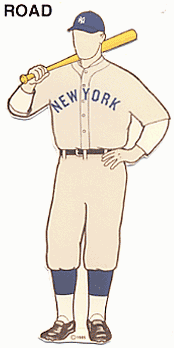 |
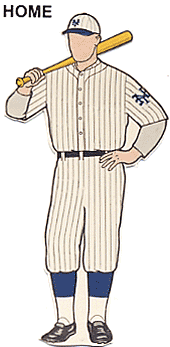 |
New York Giants
| George Burns |
CF |
.299 |
| Dave Bancroft |
SS |
.318 |
| Frankie Frisch |
3B |
.341 |
| Ross Youngs |
RF |
.327 |
| High Pockets Kelly |
1B |
.308 |
| Irish Meusel |
LF |
.329 |
| Johnny Rawlings |
2B |
.267 |
| Earl Smith |
C |
.336 |
| Art Nehf |
P |
20-10 |
|
- 35,758, an outstanding crowd for a Monday, split their allegiance about evenly between the two local teams.
- The managers chose the same hurlers they sent out for Game 2 – Art Nehf for the Giants and Waite Hoyt for the Yankees.
Art Nehf was the epitome of the "crafty lefthander."
- Nehf began his career with the Boston Braves in 1915 before coming to the Giants during the 1919 season.
- He compared favorably in size (5'9") and pitching style with Dickie Kerr, the White Sox pitcher who won two games in the 1919 World Series. Kerr had good success against the Yankees in 1921 because he threw curveballs.
- A quiet professional, Art would follow McGraw's directives without complaint. For the series, John wanted his hurlers to attack the fastball-hitting Yankees with curves and off-speed pitches, using the hard one as a waste pitch. That prescription particularly applied to the Babe.
- Nehf had turned in an outstanding performance in Game 2, surrendering only three hits only to lose to Hoyt, who gave up just two. Art basically pitched around Ruth, walking him three times.
22-year-old Waite Hoyt was known as the "Schoolboy Wonder."
- McGraw signed him right out of high school in Brooklyn when Waite was only 15 years old!
- After a brief stint with the Giants, Hoyt went to the minors but soon returned to the majors with the Boston Red Sox. He went 10-12 with them in 1919-20.
- The Yankees acquired him in the offseason in one of their many trades with Boston.
- Big Apple sportswriters predicted the Giants would have no trouble hitting Hoyt because McGraw knew him so well. Mugsy supposedly told friends that his boys would "murder" Hoyt's fastball. Scribes also thought Hoyt would have trouble in the late innings of games and could be flustered, as the Indians had done several weeks earlier.
- During workouts the day before the Series started, Ross Youngs walked with Frisch past Hoyt and said loudly, So that's the young punk who expects to beat us.
Ruth again overruled his doctors and started in left field.
- However, he was nowhere near 100%. Adding to his elbow and knee woes was a charley horse in his leg, perhaps as a result of favoring his ailing knee when running.
- Overall, Babe was in a severely weakened state. But Huggins would take a sub-par Ruth over anyone else he could put in his place.
- Babe struck out to complete a 1-2-3 first for the Yanks.
The Giants drew first blood in the bottom of the inning.
- LF George Burns hit a routine grounder that 3B Art McNally booted for his second error in as many days.
- SS Dave Bancroft forced Burns at 2nd.
- Frisch, batting left-handed against Hoyt, smacked a hit up the middle that the pitcher deflected with his bare hand. While his action caused Bancroft to stop at 2nd, Waite suffered a split finger that bothered him the rest of the game.
- Ross Youngs walked to load the bases.
- "High Pockets" Kelly, just 1-for-15 in the Series, hit a pop fly into short CF that many in the stands and press box expected fleet CF Elmer Miller to grab. But he played the ball conservatively, letting it bounce in front of him for a single to score Bancroft.
- 37-year-old Jack Quinn started warming up in the Yankees' bullpen in LCF
- Next up was Irish Meusel, older brother of Yankee RF Bob Meusel.
Irish Meusel had come to the Giants in the second of two trades they made with the lowly Phillies in July.
- On the first of the month, New York acquired veteran 2B Johnny Rawlings, who improved the infield offensively and defensively. To make room for the new addition, Frisch moved back to 3B where he had played the year before, his first full season in the bigs.
- 24 days later, McGraw traded for Meusel. The outfielder had hit .309 with 14 HRs in 1920. Since the Phillies didn't appear to have gotten equal value in return for Meusel, the first-place Pirates and other clubs cried foul. Already upset by the Rawlings trade, they claimed the Giants were trying to buy a pennant and called on Commissioner Kennesaw Landis to void the deal, just as he did the Giants' attempt to obtain 3B Heinie Groh from the Reds. Landis, however, did not veto the deal, although he admitted later that "the Meusel deal should never have gone through."
Glancing to the dugout after every pitch to get a hit/take sign from McGraw, Meusel took successive slow curves for strike two and strike three.
- Hoyt induced Rawlings to ground out to escape the jam with no further damage.
Giants 1 Yankees 0
The Yankees ran themselves out of a chance to score in the 2nd.
- Bob Meusel led off with a single to RF.
Meusel had finally found a niche in RF. With never any question about Bob's hitting, Huggins had tried him at 3B in 1920. But, as Bill Felber has put it, Line drives [off Meusel's bat] flew to all parts of the training field. Unfortunately … so did Meusel's throws from third base. So Miller stuck him in LF. But his defensive failings continued to the point where the Yankee manager benched him in early August despite a batting average in the .350s.
- Huggins, playing the "small ball" that the Giants supposedly favored, gave the bunt sign to 1B Wally Pipp, who got the job done.
- The Yankees continued to try to make something happen. Meusel took off for 3rd on Nehf's pitch to Ward. The batter struck out, and C Earl Smith's peg arrived in time for the putout, but Frisch dropped the ball. When Meusel saw it roll away, he lit out for home. However, Frankie recovered and threw to Smith to retire the runner and end the inning.
In the bottom of the 2nd, Bob Meusel atoned for his base running gaff.
- With two outs and George Burns on 1st, Bancroft singled to RF.
- Running on the pitch, Burns cruised into 3rd. Meusel grabbed the ball, faked a throw to 2B, then fired to Pipp to trap Bancroft rounding the bag too far. As the Yanks started a rundown, Burns broke for home, but Pipp's throw to C Wally Schang nailed him.
The Yanks tied the score in the 3rd.
- McNally, wanting to make up for the unearned run he gave the Giants in the 1st, drew a walk.
- Schang hit a liner that dropped in LF. Mike aggressively continued to 3rd, beating the throw. Wally took 2nd on the play and was generously awarded a double by the scorer.
- The runners held as Hoyt grounded out 6-3.
- Miller then hit a fly to LF. Irish Meusel, whose arm was adequate but not in the class of his brother, threw home and appeared to have a chance to get McNally. But SS Bancroft inexplicably cut off the throw.
A year after the Black Sox scandal came to light, somebody in the stands or press box must have wondered if Bancroft was "on the take." One of the incidents in the 1919 World Series that tipped off writers like Hugh Fullerton that something was amiss was Chicago P Eddie Cicotte intercepting a throw home that appeared to have a chance to nail the runner. Throw in the fact that Bancroft was 1-for-18 in the Series, and you had to wonder.
Other plays that might have caused comment were McNally's error and Miller's lackadaisical effort on Kelly's fly in the 1st.
- SS Roger Peckinpaugh, having a bad series at the bat like his Giant counterpart, grounded out to end the inning.
Giants 1 Yankees 1
Hoyt had to work out of another jam in the bottom of the 2nd.
- Frisch led off with a single up the middle.
- Youngs hit into a forceout.
- With two outs, Irish doubled to LF. Not playing aggressively even with an injured Ruth in LF and two outs, 3B coach Hughie Jennings held up Youngs.
- Rawlings popped out.
The Babe led off the top of the 4th and, as often happened, did something that everyone talked about for days to come.
- Ruth took several mighty practice swings before stepping in. Then, with the infield and outfield playing deep, he stunned the crowd by laying down a bunt toward 3B. Pushing his anguished body as hard as he could, Babe just beat Frisch’s throw to 1st.
The Giants howled at 1B umpire George Morarity. The call still stuck in McGraw’s craw even after the Series. I shall always claim that Ruth was out at first by two feet on his “safe” bunt which caused so much damage. The umpiring crew received poor grades during the Series from the players on both sides, the press, and the fans.
- Bob Meusel smashed a liner in the direction of his brother in LF. But Irish misplayed it, and it bounced over his head and almost hit a policeman stationed by the wall. Ruth chugged around 3rd and came all the way home as Bob coasted into 2nd. After staggering into the dugout, Babe passed out! The team doctor was summoned and revived him with spirits of ammonia. Reporters were unaware of what happened until the field announcer ran to the press and yelled, Ruth has fainted on the bench! All went quiet and wondered if the Great One would continue in the game.
- Meanwhile, Meusel went to 3rd on a groundout and scored on Aaron Ward’s sacrifice fly.
- The exciting inning ended with Burns making a sensational catch at the wall to rob McNally of a triple.
Yankees 3 Giants 1
When the Yanks took the field for the bottom of the inning, Ruth did not appear. However, after a minute or two, he came out of the dugout and took his position in LF.
The Giants continued to put men on base but couldn’t bring them around.
- C Earl Smith led off the 4th with a walk but was immediately caught stealing.
- Kelly started the 6th with a single. McGraw, adhering to his anti-sacrifice philosophy, didn’t try to move him over, and nothing came of it.
- In the 8th, Youngs and Kelly singled back-to-back to put runners at the corner with one out. Except that High Pockets decided to try for a double. Bob Meusel rifled the ball to Ward to cut Kelly down. With a chance to at least get one run, Irish fouled out.
Known for their bench jockeying, the Giants tried to rattle Hoyt all afternoon. When Hoyt grounded out in the 5th and passed the Giants dugout on the way back to his bench, a Giant – reserve OF Casey Stengel being the prime suspect - threw a bar of soap at Waite. The Yankee P picked it up and hurled it back from whence it came. He claimed it sailed just past McGraw’s ear.
In the meantime, the Yanks could give their valiant moundsman no further help.
- Miller doubled in the 5th but with two out.
- Peckinpaugh broke Nehf’s string of ten batters in a row retired with a two-out single in the 8th.
So Hoyt faced the 7-8-9 spots in the Giants lineup in the bottom of the 9th with just a two-run lead.
- Rawlings brought the Giants fans to their feet with a double to LF – the fifth inning in which the leadoff man reached base for the home team.
- But Hoyt bore down and retired Smith on a pop fly, then ended with a flourish by striking out pinch hitter Frank Snyder and leadoff man Burns.
FINAL: YANKEES 3 GIANTS 1
YANKS LEAD THE SERIES 3 GAMES TO 2.
Hoyt had now faced the best hitting club in the NL twice and given up no earned runs in 18 innings.
- The McGrawmen outhit the Yanks 10-6 but stranded ten and had three runners erased on the base paths.
- "Mugsy" gave his men a tongue-lashing after the game.
Walter Trumbull wrote that the Giants ran the bases with all the skill of a fat lady with the asthma racing for a street car.
- Huggins spoke glowingly of Ruth’s bunt and trip around the bases. It was an exhibition of greatness that will go down through history.
- However, Babe’s personal physician, Dr. George King, told reporters that Ruth should not have played the last two games and warned that he was in danger of losing his arm if he continued to play. Increased swelling around the wound would force poison into his system. He concluded: Ruth will not play again in the series.
Doctors would not even let Ruth suit up and coach 3B for fear that he would talk Huggins into putting him into the game. Reportedly, Babe’s arm was in such bad shape that he could not steer his car and needed someone to drive him to the ballpark.
- Concessionaire Harry Stevens complained that his business suffered because of the dramatic games being played. Fans were so glued to the action on the field that they didn’t want to leave their seats for refreshments. No one sympathized with Stevens, who sold 21,000 hot dogs and 3,000 bags of peanuts per game in addition to ice cream and programs.
Post-script
The Giants won the next three games against the Ruth-less (and therefore not ruthless) Yankees to take the Series 5-3.
- Ruth recuperated quickly from his injury and organized a cross-country barnstorming tour with other major leaguers.
- However, baseball rules explicitly forbade members of the World Series teams from embarking on such tours.
|


Polo Grounds during 1921 World Series
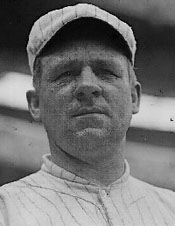
John McGraw
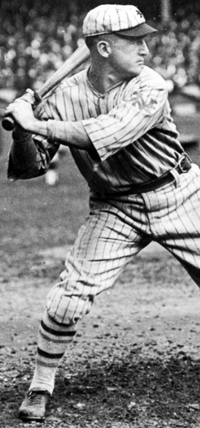
Frankie Frisch
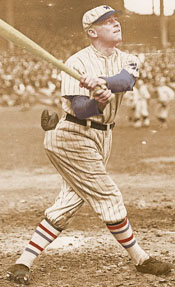
Ross Youngs

George Kelly
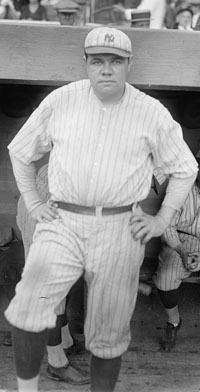
Babe Ruth 1921
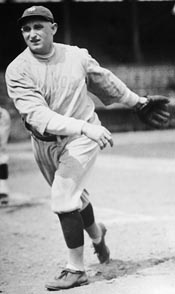
Carl Mays
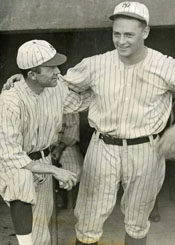
Miller Huggins and Waite Hoyt
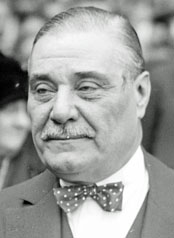
Jacob Ruppert
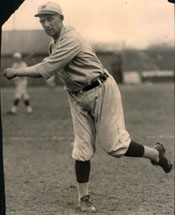
Art Nehf

George Burns
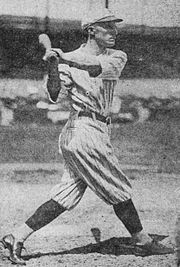
Dave Bancroft
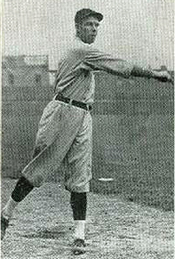
Elmer Miller
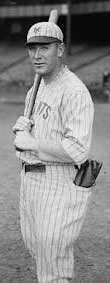
Irish Meusel
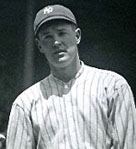
Bob Meusel
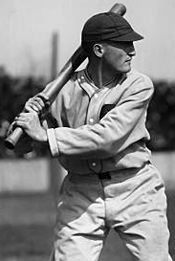
Johnny Rawlings

Roger Peckinpaugh
|